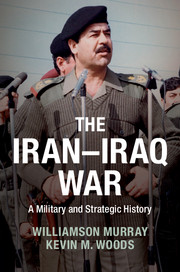Book contents
- Frontmatter
- Dedication
- Contents
- List of figures
- List of tables
- Preface
- Acknowledgments
- Note to reader
- 1 Introduction
- 2 A context of “bitterness and anger”1
- 3 The opponents
- 4 1980: The Iraqi invasion begins
- 5 1981–1982: Stalemate
- 6 Defeat and recovery
- 7 1983–1984: A war of attrition
- 8 1985–1986: Dog days of a long war
- 9 1987–1988: An end in sight?
- 10 Conclusion
- Appendix A Timeline
- Appendix B People
- Appendix C Place names
- Appendix D Order of battle
- Bibliography
- Index
- References
2 - A context of “bitterness and anger”1
Published online by Cambridge University Press: 05 September 2014
- Frontmatter
- Dedication
- Contents
- List of figures
- List of tables
- Preface
- Acknowledgments
- Note to reader
- 1 Introduction
- 2 A context of “bitterness and anger”1
- 3 The opponents
- 4 1980: The Iraqi invasion begins
- 5 1981–1982: Stalemate
- 6 Defeat and recovery
- 7 1983–1984: A war of attrition
- 8 1985–1986: Dog days of a long war
- 9 1987–1988: An end in sight?
- 10 Conclusion
- Appendix A Timeline
- Appendix B People
- Appendix C Place names
- Appendix D Order of battle
- Bibliography
- Index
- References
Summary
As a rule those who were least remarkable for intelligence showed the greater powers of survival. Such people recognized their own deficiencies and the superior intelligence of their opponents; fearing that they might lose a debate or find themselves out-maneuvered in intrigue by their quick witted enemies, they boldly launched into action; while their opponents, overconfident in the belief that they would see what was happening in advance, and not thinking it necessary to seize by force what they could secure by policy, were more easily destroyed because they were off their guard.
– Thucydides[On] the subject of our relations with Iran – Iran planned animosity for us from the beginning. [It is] as if the change [that] took place in Iran was designed with the intentions to be against the interests of Iraq.
–Saddam HusseinNot surprisingly, the origins of the Iran–Iraq War lie deep in the past. In fact, until the early twentieth century, when the British stitched together disparate provinces of the Ottoman Empire that they had acquired in the political fallout from that empire’s collapse, there was no such political entity as Iraq. Yet, the territory from which modern Iraq emerged has been at the center of world events since the dawn of history. Along with Egypt and China, the Mesopotamian Valley gave birth to the earliest of human civilizations. Beginning in the third millennium bc, small Semitic tribes combined with the Akkadians and Sumerians to build a prosperous city-state culture around Ur and Babylon. Theirs were societies born in the harsh conditions of subsistence agriculture, which forced them to constantly balance their actions in a world caught between disaster and opulence.
Change in Mesopotamia was often swift and violent. The life-giving rivers represented a capricious resource, often failing to flood or flooding too much. This gave rise to a particular fatalism – so-called Babylonian “pessimism” – within a culture where nothing was sure and the future was of little comfort. Nature was not the only source of gloom. During the centuries, Hittites, Assyrians, Persians, Greeks, Romans, Parthians, Byzantines, Arabs, Mongols, Ottomans, Britons, and Americans have all invaded, devastated, and then, in a fashion, ruled, but never fully subdued Mesopotamia.
- Type
- Chapter
- Information
- The Iran–Iraq WarA Military and Strategic History, pp. 9 - 50Publisher: Cambridge University PressPrint publication year: 2014

